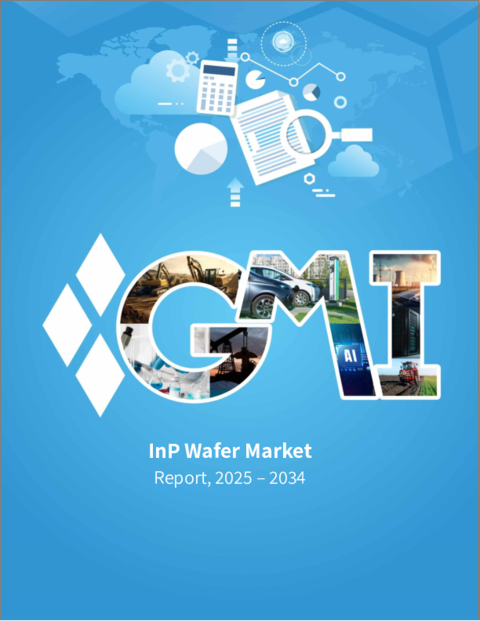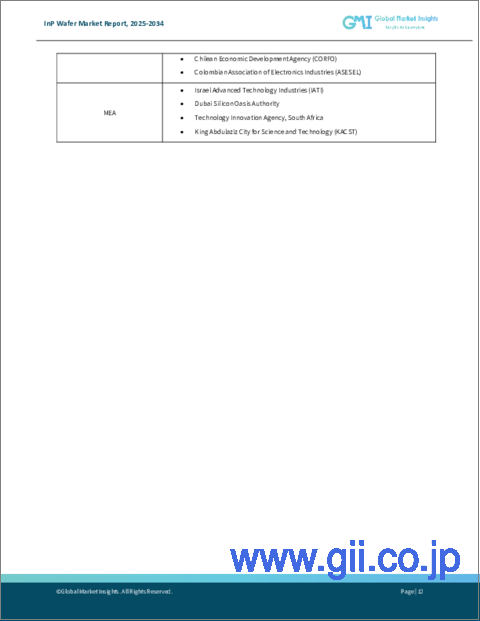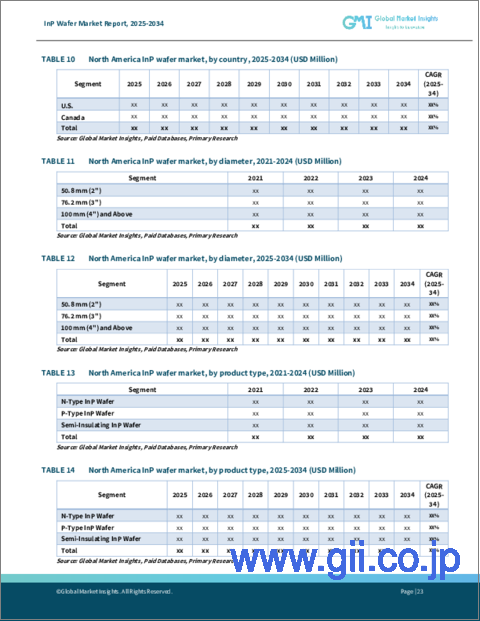|
|
市場調査レポート
商品コード
1639264
InPウェハ市場の機会、成長促進要因、産業動向分析、2024年~2032年の予測InP Wafer Market Opportunity, Growth Drivers, Industry Trend Analysis, and Forecast 2024-2032 |
||||||
カスタマイズ可能
|
|||||||
| InPウェハ市場の機会、成長促進要因、産業動向分析、2024年~2032年の予測 |
|
出版日: 2024年11月22日
発行: Global Market Insights Inc.
ページ情報: 英文 200 Pages
納期: 2~3営業日
|
全表示
- 概要
- 目次
世界のInPウェハ市場は、2023年に1億7,000万米ドルと評価され、2024年から2032年にかけてCAGR11.5%で拡大すると予測されています。
この成長の主因は、200mm化合物半導体エピウエハーに対する需要の増加です。このウエハーは、大量生産をサポートし、単位当たりのコストを下げるという点で大きな利点を提供します。これらのウエハは、フォトニクスやオプトエレクトロニクスなどの分野での用途に特に求められています。
InPウェハ市場は、直径別に4つの主要セグメントに分類される:50.8mm(2インチ)、76.2mm(3インチ)、100mm(4インチ)以上です。このうち、50.8mm(2インチ)セグメントは大幅な成長が見込まれており、2032年の市場規模は3億260万米ドルと予想されています。このセグメントは、費用対効果と性能の最適な組み合わせにより、最も顕著な存在となっています。50.8mmウエハは、通信、フォトニクス、3DセンシングやLiDARなどの新技術を含む幅広い用途に最適で、効率的な生産を確保しながら高品質な性能を提供します。
同市場は、製品タイプ別にも分けられており、N-Type InPウェハ、P-Type InPウェハ、半絶縁性InPウェハがあります。P-TypeInPウェハの成長が最も速く、2024年から2032年までのCAGRは13.2%です。この成長の原動力は、オプトエレクトロニクスデバイス、特に発光ダイオード(LED)やレーザーダイオードのようなアプリケーションでP-Typeウエハの採用が増加していることです。P-TypeInPウェハの需要は、3Dセンシング、LiDAR、光通信などの次世代技術における重要性から高まっています。さらに、フォトニクスの進歩や、よりエネルギー効率の高いパワーエレクトロニクスの推進が、このセグメントの成長を支えています。
| 市場範囲 | |
|---|---|
| 開始年 | 2023 |
| 予測年 | 2024-2032 |
| 開始金額 | 1億7,000万米ドル |
| 予測金額 | 4億4,440万米ドル |
| CAGR | 11.5% |
北米のInPウェハ市場は2023年に39.4%を占める。米国のInPウェハ市場の急拡大は、同国が5Gネットワーク、光通信、自律走行車などの最先端技術に多額の投資を行っていることに起因しています。通信、航空宇宙、防衛などの産業における高性能半導体への需要が、InPウェハの普及を後押ししています。優れた電子特性と光特性で知られるInPウエハは、こうしたハイテク分野の性能要件を満たすのに不可欠です。
まとめると、InPウェハ市場は、産業界が様々な用途に高度で高性能な半導体を求める中、大きな成長を遂げようとしています。通信、オプトエレクトロニクス、エネルギー効率の高いエレクトロニクスの技術開発が続くことで、今後10年間の市場開拓はさらに進むと思われます。
目次
第1章 調査手法と調査範囲
第2章 エグゼクティブサマリー
第3章 業界洞察
- エコシステム分析
- バリューチェーンに影響を与える要因
- 利益率分析
- 破壊
- 将来の展望
- メーカー
- 流通業者
- サプライヤーの状況
- 利益率分析
- 主要ニュースと取り組み
- 規制状況
- 影響要因
- 促進要因
- 200mm化合物半導体エピウエハー需要の増加
- 自動車および自律走行システムへの採用
- データセンターと高速接続の成長
- 高効率レーダー・ソリューションの需要
- フォトニクスとオプトエレクトロニクスの需要拡大
- 業界の潜在的リスク&課題
- ウエハーサイズの選択肢の狭さ
- 代替材料との競合
- 促進要因
- 成長可能性分析
- ポーター分析
- PESTEL分析
第4章 競合情勢
- イントロダクション
- 企業シェア分析
- 競合のポジショニング・マトリックス
- 戦略展望マトリックス
第5章 市場推計・予測:直径別、2021年~2032年
- 主要動向
- 50.8 mm(2インチ)
- 76.2 mm(3インチ)
- 100 mm(4インチ)以上
第6章 市場推計・予測:製品タイプ別、2021年~2032年
- 主要動向
- N型InPウェハ
- P型InPウェハ
- 半絶縁性InPウェハ
第7章 市場推計・予測:最終用途産業別、2021年~2032年
- 主要動向
- 家電
- 通信
- 医療
- その他
第8章 市場推計・予測:用途別、2021年~2032年
- 主要動向
- オプトエレクトロニクス
- フォトニック集積回路
- RF/マイクロ波デバイス
- パワーエレクトロニクス
- 研究開発
- その他
第9章 市場推計・予測:地域別、2021年~2032年
- 主要動向
- 北米
- 米国
- カナダ
- 欧州
- 英国
- ドイツ
- フランス
- イタリア
- スペイン
- ロシア
- アジア太平洋
- 中国
- インド
- 日本
- 韓国
- オーストラリア
- ラテンアメリカ
- ブラジル
- メキシコ
- 中東・アフリカ
- UAE
- 南アフリカ
- サウジアラビア
第10章 企業プロファイル
- AXT Inc.
- Broadcom Inc.
- CMK Ltd.
- DOWA Electronics Materials Co., Ltd.
- Freiberger Compound Materials GmbH
- JX Nippon Mining & Metals Corporation
- Logitech Ltd.
- MTI Corporation
- Nanografi Nano Technology.
- Sumitomo Electric Semiconductor Materials Inc.
- Umicore
- Veeco Instruments Inc.
- Wafer Technology Ltd.
- Western Minmetals(SC)Corporation
- Xiamen Powerway Advanced Material Co. Ltd
- Yunnan Germanium Co., Ltd.
The Global InP Wafer Market was valued at USD 170 million in 2023 and is projected to expand at 11.5% CAGR from 2024 to 2032. This growth is largely driven by the increasing demand for 200 mm compound semiconductor epi wafers, which offer significant advantages in terms of supporting high-volume production and lowering per-unit costs. These wafers are particularly sought after for applications in fields such as photonics and optoelectronics.
The InP wafer market is categorized by diameter into four key segments: 50.8 mm (2"), 76.2 mm (3"), 100 mm (4"), and above. Among these, the 50.8 mm (2") segment is expected to see substantial growth, with an anticipated market value of USD 302.6 million by 2032. This segment is the most prominent due to its optimal combination of cost-effectiveness and performance. The 50.8 mm wafers are ideal for a wide range of applications, including telecommunications, photonics, and emerging technologies such as 3D sensing and LiDAR, where they offer high-quality performance while ensuring efficient production.
The market is also divided based on product type, which includes N-Type InP Wafer, P-Type InP Wafer, and Semi-Insulating InP Wafer. The P-Type InP wafer segment is expected to experience the fastest growth, with a CAGR of 13.2% from 2024 to 2032. This growth is fueled by the increasing adoption of P-Type wafers in optoelectronic devices, particularly in applications like light-emitting diodes (LEDs) and laser diodes. The demand for P-Type InP wafers is rising due to their importance in next-generation technologies, such as 3D sensing, LiDAR, and optical communications. Additionally, advancements in photonics and the drive for more energy-efficient power electronics are supporting the growth of this segment.
| Market Scope | |
|---|---|
| Start Year | 2023 |
| Forecast Year | 2024-2032 |
| Start Value | $170 Million |
| Forecast Value | $444.4 Million |
| CAGR | 11.5% |
North America InP wafer market held 39.4% in 2023. The rapid expansion of the U.S. InP wafer market is attributed to the country's significant investments in cutting-edge technologies, including 5G networks, optical communications, and autonomous vehicles. The demand for high-performance semiconductors in industries such as telecommunications, aerospace, and defense is driving the widespread use of InP wafers. Known for their superior electronic and photonic properties, InP wafers are essential in meeting the performance requirements of these high-tech sectors.
In summary, the InP wafer market is poised for significant growth as industries demand advanced, high-performance semiconductors for a variety of applications. The continued development of technologies in telecommunications, optoelectronics, and energy-efficient electronics will further contribute to the market's expansion over the next decade.
Table of Contents
Chapter 1 Methodology & Scope
- 1.1 Market scope & definition
- 1.2 Base estimates & calculations
- 1.3 Forecast calculation
- 1.4 Data sources
- 1.4.1 Primary
- 1.4.2 Secondary
- 1.4.2.1 Paid sources
- 1.4.2.2 Public sources
Chapter 2 Executive Summary
- 2.1 Industry 360° synopsis, 2021-2032
Chapter 3 Industry Insights
- 3.1 Industry ecosystem analysis
- 3.1.1 Factor affecting the value chain
- 3.1.2 Profit margin analysis
- 3.1.3 Disruptions
- 3.1.4 Future outlook
- 3.1.5 Manufacturers
- 3.1.6 Distributors
- 3.2 Supplier landscape
- 3.3 Profit margin analysis
- 3.4 Key news & initiatives
- 3.5 Regulatory landscape
- 3.6 Impact forces
- 3.6.1 Growth drivers
- 3.6.1.1 Increased demand for 200 mm compound semiconductor epi wafers.
- 3.6.1.2 Adoption in automotive and autonomous systems
- 3.6.1.3 Growth of data centers and high-speed connectivity
- 3.6.1.4 Demand for high-efficiency radar solutions
- 3.6.1.5 Growing photonics and optoelectronics demand
- 3.6.2 Industry pitfalls & challenges
- 3.6.2.1 Limited wafer size options
- 3.6.2.2 Competition from alternative materials
- 3.6.1 Growth drivers
- 3.7 Growth potential analysis
- 3.8 Porter's analysis
- 3.9 PESTEL analysis
Chapter 4 Competitive Landscape, 2023
- 4.1 Introduction
- 4.2 Company market share analysis
- 4.3 Competitive positioning matrix
- 4.4 Strategic outlook matrix
Chapter 5 Market Estimates & Forecast, By Diameter, 2021-2032 (USD million)
- 5.1 Key trends
- 5.2 50.8 mm (2")
- 5.3 76.2 mm (3")
- 5.4 100 mm (4") and Above
Chapter 6 Market Estimates & Forecast, By Product Type, 2021-2032 (USD million)
- 6.1 Key trends
- 6.2 N-Type InP Wafer
- 6.3 P-Type InP Wafer
- 6.4 Semi-Insulating InP Wafer
Chapter 7 Market Estimates & Forecast, By End Use Industry, 2021-2032 (USD million)
- 7.1 Key trends
- 7.2 Consumer electronics
- 7.3 Telecommunications
- 7.4 Medical
- 7.5 Others
Chapter 8 Market Estimates & Forecast, By Application, 2021-2032 (USD million)
- 8.1 Key trends
- 8.2 Optoelectronics
- 8.3 Photonic integrated circuits
- 8.4 RF/Microwave devices
- 8.5 Power electronics
- 8.6 Research & development
- 8.7 Others
Chapter 9 Market Estimates & Forecast, By Region, 2021-2032 (USD million)
- 9.1 Key trends
- 9.2 North America
- 9.2.1 U.S.
- 9.2.2 Canada
- 9.3 Europe
- 9.3.1 UK
- 9.3.2 Germany
- 9.3.3 France
- 9.3.4 Italy
- 9.3.5 Spain
- 9.3.6 Russia
- 9.4 Asia Pacific
- 9.4.1 China
- 9.4.2 India
- 9.4.3 Japan
- 9.4.4 South Korea
- 9.4.5 Australia
- 9.5 Latin America
- 9.5.1 Brazil
- 9.5.2 Mexico
- 9.6 MEA
- 9.6.1 UAE
- 9.6.2 South Africa
- 9.6.3 Saudi Arabia
Chapter 10 Company Profiles
- 10.1 AXT Inc.
- 10.2 Broadcom Inc.
- 10.3 CMK Ltd.
- 10.4 DOWA Electronics Materials Co., Ltd.
- 10.5 Freiberger Compound Materials GmbH
- 10.6 JX Nippon Mining & Metals Corporation
- 10.7 Logitech Ltd.
- 10.8 MTI Corporation
- 10.9 Nanografi Nano Technology.
- 10.10 Sumitomo Electric Semiconductor Materials Inc.
- 10.11 Umicore
- 10.12 Veeco Instruments Inc.
- 10.13 Wafer Technology Ltd.
- 10.14 Western Minmetals (SC) Corporation
- 10.15 Xiamen Powerway Advanced Material Co. Ltd
- 10.16 Yunnan Germanium Co., Ltd.






